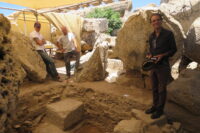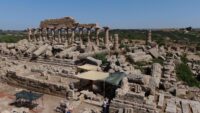 A team of archaeologists and student volunteers from New York University (NYU) and the University of Milan (UniMi) have discovered the remains of a monumental two-storey platform believed to have been part of the altar of the oldest Greek temple in Selinunte, western Sicily.
A team of archaeologists and student volunteers from New York University (NYU) and the University of Milan (UniMi) have discovered the remains of a monumental two-storey platform believed to have been part of the altar of the oldest Greek temple in Selinunte, western Sicily.
The mission led by professors Clemente Marconi, Rosalia Pumo and Andrew Ward brought the discovery of part of a monumental platform on two levels that was likely used to house the main altar of Temple R, the oldest in the city, dated archaeologically to 570 BC.
This is the same area where, in 2010, researchers with the NYU-UniMi mission found abundant remains of animal sacrifice.
Among the finds were also two spearheads that were found burnt and crossed. “A truly exceptional case in the Greek world to find them like this,” said professor Marconi.
“It was typical of female cults to have dedications of weapons, and the finding in front of Temple R, dedicated to a goddess, is certainly not accidental,” he said.
It is a historical testimony of two different phases of the city: the lower platform dates to the years of construction of Temple R; while the higher platform, more monumental, dates to the 5th century.
During the excavation, a large goat’s horn was also unearthed, evidence of a prestigious sacrifice to the divinity.
A fourth artefact found was a fragment of a life-sized statue made of Parian marble. It is an additional piece of the arm of a kouros, a male statue with a votive function, of which a fragment of the forearm was found four years ago during the NYU-UniMi campaign.
“This is the first time that a statue of this type in marble and life-size has been discovered in Selinunte,” said Clemente Marconi.
“It was most likely dedicated in the sixth century and then dismembered in the fourth century and the fragments partly used as lime, with others used for Hellenistic fill”.
Founded as a Greek colony in the second half of the 7th century B.C., ancient Selinus flourished thanks to its rich farmland and the city thanked its gods for its prosperity by building monumental Doric temples. The most important sanctuaries were built on the city’s Acropolis, and today extensive remains survive of three 6th century temples, Temple C, dedicated to Apollo, and Temple D, dedicated to Athena, and Temple R.
 After a period of neglect and decline after being conquered by Carthage in 409 B.C., Selinunte rebounded with new building programs including Temple B, built around 300 B.C. Fifty years later, the city was destroyed and its population forcibly deported to Lilybaeum by the Carthaginian during the First Punic War.
After a period of neglect and decline after being conquered by Carthage in 409 B.C., Selinunte rebounded with new building programs including Temple B, built around 300 B.C. Fifty years later, the city was destroyed and its population forcibly deported to Lilybaeum by the Carthaginian during the First Punic War.
NYU archaeologists have been investigation the Acropolis of Selinunte since 2006. In 2019, they discovered the first evidence of a bull sacrifice at Selinunte: a votive deposit of two bull horns in a 7th century cult building on the east side of Temple R. This season’s excavation focused on the area in front of Temple R. This space has never been excavated, not even in antiquity, leaving behind unusually pristine archaeological layers which has given the team the ability to date the finds and reconstruct the different phases of construction and use of Temple R.